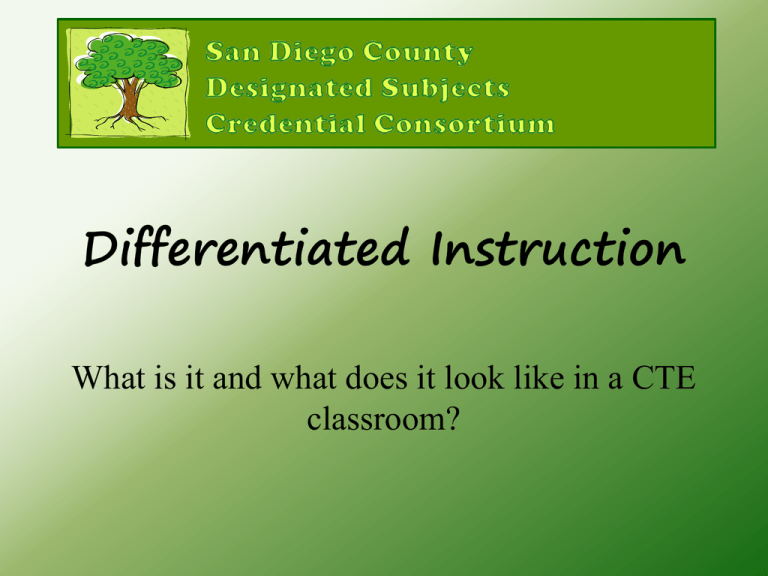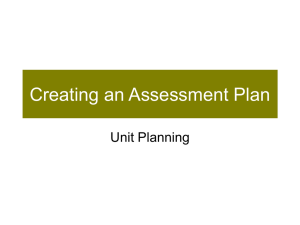Differentiated_Instruction - San Diego County Office of Education
advertisement

Differentiated Instruction What is it and what does it look like in a CTE classroom? Definition: Differentiated instruction is: • An instructional theory • Takes diverse student factors into account when planning and delivering instruction. • Based on this theory, teachers can structure learning environments that address the variety of learning styles, interests, and abilities found within a classroom. How does it work?: Differentiated instruction is based upon the belief that: • Students learn best when they make connections between the curriculum and their diverse interests and experiences. • The greatest learning occurs when students are pushed slightly beyond the point where they can work without assistance. What does it mean for teachers?: Teachers DO • Provide several learning options, or different paths to learning, which help students take in information and make sense of concepts and skills. • Provide appropriate levels of challenge for all students, including those who lag behind, those who are advanced, and those right in the middle. Teachers DON'T • Develop a separate lesson plan for each student in a classroom. • “Water down" the curriculum for some students. What is Program Standard Fifteen? Standard 15 Teaching English Learners • Candidates know and apply specially designed academic instruction in English (SDAIE) to make curriculum content comprehensible to English learners. Is SDAIE the same as Differentiated Instruction?: Yes! For example: From California Standards for the Teaching Profession (CSTP) • Standard 1: Engaging and Supporting All Students in Learning • Specifically 1.4: Using a variety of instructional strategies, resources, and technologies to meet students’ diverse learning needs No, really, is it? Yes, again ! From the Teacher Performance Expectations (TPE’s) TPE 4 –Making Content Accessible • Incorporating specific strategies that motivate students to learn (meeting student academic learning needs in a variety of ways.) TPE 7 - Teaching English Learners (in part) • Designs lesson to make learning strategies explicit Learning Inventories • Understanding how the students in the classroom learn and what kind of learners they are is important to know. • One learning style inventory is VARK. The VARK inventory lets the students learn how they learn best by answering a series of questions. Learning Inventories • Teachers can conduct a learning style interest inventory by completing the inventory in the computer lab, allow the students to use their mobile devices, or use Poll Everywhere as a guided classroom activity or assign it as homework. • VARK Learning Style Inventory The Basics Content Content (what students learn) • Includes curriculum topics, concepts, or themes. • Reflects state or national standards. • Presents essential facts and skills. • Differentiates by pre-assessing student skills and understandings, then matching learners with appropriate activities. • Provides students with choices in order to add depth to learning. • Provides students with additional resources that match their levels of understanding. Process Process (how students learn) • Refers to how students make sense or understand the information, ideas, and skills being studied. • Reflects student learning styles and preferences. • Varies the learning process depending upon how students learn. Product Product (the end result of student learning) • Tends to be tangible: reports, tests, brochures, speeches, skits. • Reflects student understanding. • Differentiates by providing challenge, variety, and choice. Differentiated Instruction in the CTE Classroom Preparing Lesson Plans: • CTE courses are by their very nature, lend themselves hands-on, project-based learning. • One way to approach differentiation is the KUD Method (Know, Understand, Do) Example: KUD Samples from High School Teachers Patrick Johner, Todd County High School Land and Water of North Africa and Southwest and Central Asia, 9th grade unit • K: Students will know the land and water features of the region. • U: Students will understand how the region’s major rivers are important to the region and why • much of the world is economically dependent upon the region. • D: Students will build a layered-look book on the land and water of the region. Strategies Menus • A menu offers students a way to make decisions about what they will do in order to meet class requirements. A menu could be for a single lesson, a week-long lesson, or even a month-long period of study. Once the teacher has decided on what the essential understanding and/or skills are, she/he can begin to create a menu. Strategies Tic-Tac-Toe • Tic-Tac-Toe choice boards give students the opportunity to participate in multiple tasks that allow them to practice skills they’ve learned in class or to demonstrate and extend their understanding of concepts. From the board, students either choose or are assigned three adjacent or diagonal tasks to complete Websites To Explore • • • • • • • • • • • • A Different Place http://www.adifferentplace.org/ 4teachers.org http://www.4teachers.org/ Odds ‘n Ends: More Ways to Differentiate http://www.gp.k12.mi.us/ci/diff/diff/oddsends.htm Layered Curriculum® http://help4teachers.com ASCD: Education Topics/Differentiation Instruction http://www.ascd.org/ Differentiated Instruction Resources http://www.sde.com/Conferences/DifferentiatedInstruction/DIResources.htm References • Teaching Today Differentiated Instruction Retrieved March 4, 2013 from http://www.glencoe.com/sec/teachingtoday/subjec t/di_meeting.phtml • Benjamin, Amy. Differentiated Instruction: A Guide for Middle and High School Teachers. Larchmont, NY: Eye on Education, 2002. • Tomlinson, Carol Ann, and Caroline Cunningham Eidson. Differentiation in Practice: A Resource Guide for Differentiating Curriculum, Grades 59. Alexandria, VA: ASCD, 2003.











